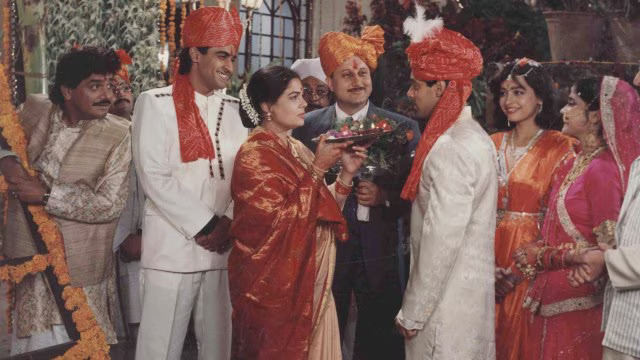When Hum Aapke Hain Koun first released back in 1994, it was seen as the film that brought the audience back to the theatres. There wasn’t a pandemic that pushed people away instead the movie industry was going through a creativity crisis as it pushed out terrible movies, pushing audiences away. Some would argue that this phase lasted for almost a decade. The idea of watching movies at home at one’s convenience was introduced right around the same time and satellite television was starting to gain a foothold in India. But despite all of that, the Sooraj Barjatya film, starring Madhuri Dixit and Salman Khan, was a must-watch for families of all sizes living in different parts of the country. So what was it about Hum Aapke Hain Koun that drew millions of people to the theatres?
For a big chunk of the millennial population, Hum Aapke Hain Koun was one of their first introductions to movies. A three-and-a-half hour festival where human beings were presented as ideal specimens of kindness and nobility had a fairytale-like quality. Here, everyone was selfless, spoke softly, and didn’t have an ounce of malice in their being. Kids with an impressionable mind didn’t know much better and so Hum Aapke Hain Koun looked more than acceptable to them. But as it happens in life, kids grow up, and the ideas that once looked ideal now feel forced. The perfection presented here started appearing manufactured, and Hum Aapke Hain Koun appeared as an unrealistic portrayal of a family where characters looked excessively sugar-coated, as they promoted patriarchy. But, back in the day, Hum Aapke Hain Koun sold an unrealistic dream – that of a happy family – and this is perhaps what made it one of the most successful films ever.
Hum Aapke Hain Koun starts as the story of a happy family. The oldest son of the family gets married to a woman, and they are even happier. All’s well until the woman who is at the centre of their world dies in a freak accident and after grieving the loss, the family gets back together to celebrate the next chapter of their life. But while all of this is going on, you realise that there are no villains in this film and the only conflict here is death. It’s as if the film believes that nothing but death can come in the way of your family’s happiness and all the petty arguments that go on in every household mean nothing in the larger scheme of things. It would be the perfect dream to live in a house where everyone loves each other and there is no room for any conflict, and who wouldn’t want to imagine themselves living in this cinematic paradise, even if it’s for a few hours. Cinema in India has always been aspirational and what could be more aspirational than to have a peaceful home?

But having said that, Hum Aapke Hain Koun is a product of its time and revisiting it today would make you wonder if it would have a chance now. Heroes have gone from being the ideal good boys who would fly to the other end of the world to impress the heroine’s bauji to men who cheat on their wives and ask their girlfriends to lick their shoes. The latter is morally objectionable but he has certainly found a place in pop culture, while the former has now started to look like a unidimensional character who pretends not to have any skeletons in his closet. The good boys aren’t the flavour of the season and neither are those good old family movies where they match steps and sing 13 songs in 3 hours, like in this film.
Hum Aapke Hain Koun is a relic of the past, and not just in the way it chooses to ignore one’s flaws, but also in the way it internalises misogyny to the degree that an unsuspecting person might even think that it was probably an innocent mistake. Women in this world, mainly the protagonist (played by Madhuri) and the primary supporting character (played by Renuka Shahane), have no jobs, no life outside of their homes, and have no friends. They take pride in waking up at the crack of dawn to take care of the men of the household. Their primary role is that of a birth-giver or a parental figure, and anything else that they might do comes secondary. Old-fashioned gender roles are not only established, they are celebrated with song-and-dance.

Hum Aapke Hain Koun advertises a near-impossible dream, and people lined up to buy it. However, as it completes three decades today, one wonders whether the India we live in today would buy into that fantasia.




